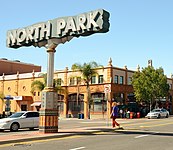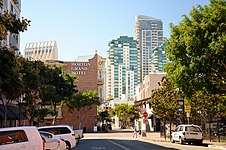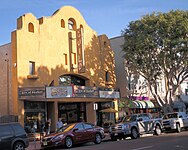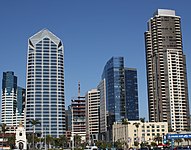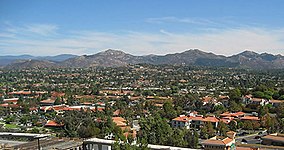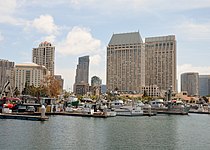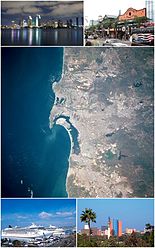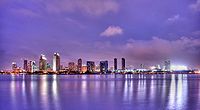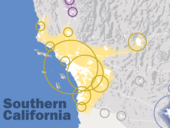San Diego
San Diego | ||
|---|---|---|
California Tower at Balboa Park | ||
|
Strong Mayor[3] | ||
| • Body | San Diego City Council | |
| • Mayor | Todd Gloria (D) | |
| • City Attorney | Mara Elliott (D)[4] | |
| • City Council[5] | List | |
| • State Assembly Members | List
| |
| • State Senators | List
| |
| Area FIPS code | 06-66000 | |
| GNIS feature IDs | 1661377, 2411782 | |
| Website | www | |
San Diego (
Historically home to the
San Diego's main economic engines are military and defense-related activities, tourism, international trade, research, and manufacturing. The city is the economic center of the San Diego–Tijuana conurbation, the second-most populous transborder metropolitan area in the Western Hemisphere (after Detroit–Windsor), home to an estimated 4.9 million people as of 2012[update].[16] The primary border crossing between San Diego and Tijuana, the San Ysidro Port of Entry, is the busiest international land border crossing in the world outside of Asia (fourth-busiest overall). The city's airport, San Diego International Airport, is the busiest single-runway airport in the world.[17]
Name
Etymology
San Diego's name can be traced back to the 16th century when Spanish explorer Sebastián Vizcaíno bestowed it upon the area in 1602. He named the bay and the surrounding area "San Diego de Alcalá" in honor of Saint Didacus of Alcalá.[18]
Kumeyaay Toponymy
Prior to the Spanish establishment of San Diego, the Kumeyaay town was called Kosa'aay, meaning "drying out place" in the Kumeyaay language.[19] After the establishment of San Diego, the Kumeyaay called town and city Tepacul Watai, meaning "Stacked Big".[20] Luiseño speakers in the North County region called it Pushuyi.[21]
History
Pre-colonial period
What has been referred to as the San Dieguito complex was established in the area at least 9,000 years ago.[22] The Kumeyaay may have culturally evolved from this complex or migrated into the area around 1000 C.E.[23] Archaeologist Malcolm Rogers hypothesized that the early cultures of San Diego were separate from the Kumeyaay, yet this claim is disputed, with others noting that it does not account for cultural evolution.[24] Rogers later reevaluated his claims, yet they were influential in shaping historical tellings of early San Diego history.[24]
The Kumeyaay established villages scattered across the region, including the village of Kosa'aay which was the Kumeyaay village that the future settlement of San Diego would stem from in today's Old Town.[19][25] The village of Kosa'aay was made up of thirty to forty families living in pyramid-shaped housing structures and was supported by a freshwater spring from the hillsides.[19]
Spanish period

The first European to visit the region was explorer
The permanent
In May 1769, Portolà established the Fort Presidio of San Diego on a hill near the San Diego River above the Kumeyaay village of Cosoy,[19] which would later become incorporated into the Spanish settlement,[25] making it the first settlement by Europeans in what is now the state of California. In July of the same year, Mission San Diego de Alcalá was founded by Franciscan friars under Serra.[28][29] The mission became a site for a Kumeyaay revolt in 1775, which forced the mission to relocate six miles (10 km) up the San Diego River.[30] By 1797, the mission boasted the largest native population in Alta California, with over 1,400 neophytes living in and around the mission proper.[31] Mission San Diego was the southern anchor in Alta California of the historic mission trail El Camino Real. Both the Presidio and the Mission are National Historic Landmarks.[32][33]
Mexican period
In 1821, Mexico won its independence from Spain, and San Diego became part of the Mexican territory of Alta California. In 1822, Mexico began its attempt to extend its authority over the coastal territory of Alta California. The fort on Presidio Hill was gradually abandoned, while the town of San Diego grew up on the level land below Presidio Hill. The Mission was secularized by the Mexican government in 1834, and most of the Mission lands were granted to former soldiers. The 432 residents of the town petitioned the governor to form a pueblo, and Juan María Osuna was elected the first alcalde ("municipal magistrate"), defeating Pío Pico in the vote. Beyond the town, Mexican land grants expanded the number of California ranchos that modestly added to the local economy. (See, List of pre-statehood mayors of San Diego.)
However, San Diego had been losing population throughout the 1830s, due to increasing tension between the settlers and the indigenous Kumeyaay and in 1838 the town lost its pueblo status because its size dropped to an estimated 100 to 150 residents.[34] The ranchos in the San Diego region would face Kumeyaay raids in the late 1830s and the town itself would face raids in the 1840s.[35]
Americans gained an increased awareness of California, and its commercial possibilities, from the writings of two countrymen involved in the often officially forbidden, to foreigners, but economically significant hide and tallow trade, where San Diego was a major port and the only one with an adequate harbor: William Shaler's "Journal of a Voyage Between China and the North-Western Coast of America, Made in 1804" and Richard Henry Dana's more substantial and convincing account, of his 1834–36 voyage, the classic Two Years Before the Mast.[36]

In 1846, the United States went to war against Mexico and sent a naval and land
In the ensuing
American period

The state of California was admitted to the United States in 1850. That same year San Diego was designated the seat of the newly established County of San Diego and was incorporated as a city.
The original town of San Diego was located at the foot of Presidio Hill, in the area which is now
In the late 1860s,
In 1912, San Diego was the site of a
In 1916, the neighborhood of Stingaree, the original home of San Diego's first Chinatown and "Soapbox Row", was demolished by anti-vice campaigners to make way for the Gaslamp Quarter.[46]

In the early part of the 20th century, San Diego hosted the
The southern portion of the

During
After World War II, the military continued to play a major role in the local economy, but post-Cold War cutbacks took a heavy toll on the local defense and aerospace industries. The resulting downturn led San Diego leaders to seek to diversify the city's economy by focusing on research and science, as well as tourism.[59]

From the start of the 20th century through the 1970s, the American
Downtown San Diego was in decline in the 1960s and 1970s, but experienced some urban renewal since the early 1980s, including the opening of
As the Cold War ended, the military shrank and so did defense spending. San Diego has since become a center of the emerging biotech industry and is home to telecommunications giant Qualcomm. San Diego had also grown in the tourism industry with the popularity of attractions such as the San Diego Zoo, SeaWorld San Diego, and Legoland California in Carlsbad.[citation needed]
Geography
According to SDSU professor emeritus Monte Marshall, San Diego Bay is "the surface expression of a north-south-trending, nested graben". The Rose Canyon and Point Loma fault zones are part of the San Andreas Fault system. About 40 miles (64 km) east of the bay are the Laguna Mountains in the Peninsular Ranges, which are part of the backbone of the American continents.[65]
The city lies on approximately 200 deep canyons and hills separating its mesas, creating small pockets of natural open space scattered throughout the city and giving it a hilly geography.[66] Traditionally, San Diegans have built their homes and businesses on the mesas, while leaving the urban canyons relatively wild.[67] Thus, the canyons give parts of the city a segmented feel, creating gaps between otherwise proximate neighborhoods and contributing to a low-density, car-centered environment. The San Diego River runs through the middle of San Diego from east to west, creating a river valley that serves to divide the city into northern and southern segments. During the historic period and presumably earlier as well, the river has shifted its flow back and forth between San Diego Bay and Mission Bay, and its fresh water was the focus of the earliest Spanish explorers. Miguel Costansó, a cartographer, wrote in 1769, "When asked by signs where the watering-place was, the Indians pointed to a grove which could be seen at a considerable distance to the northeast, giving to understand that a river or creek flowed through it, and that they would lead our men to it if they would follow."[68][69] That river was the San Diego River.[68] Several reservoirs and Mission Trails Regional Park also lie between and separate developed areas of the city.

Notable peaks within the city limits include Cowles Mountain, the highest point in the city at 1,591 feet (485 m);[7] Black Mountain at 1,558 feet (475 m); and Mount Soledad at 824 feet (251 m). The Cuyamaca Mountains and Laguna Mountains rise to the east of the city, and beyond the mountains are desert areas. The Cleveland National Forest is a half-hour drive from downtown San Diego. Numerous farms are found in the valleys northeast and southeast of the city.
Climate
| San Diego | ||||||||||||||||||||||||||||||||||||||||||||||||||||||||||||
|---|---|---|---|---|---|---|---|---|---|---|---|---|---|---|---|---|---|---|---|---|---|---|---|---|---|---|---|---|---|---|---|---|---|---|---|---|---|---|---|---|---|---|---|---|---|---|---|---|---|---|---|---|---|---|---|---|---|---|---|---|
| Climate chart (explanation) | ||||||||||||||||||||||||||||||||||||||||||||||||||||||||||||
| ||||||||||||||||||||||||||||||||||||||||||||||||||||||||||||
| ||||||||||||||||||||||||||||||||||||||||||||||||||||||||||||
Under the
The climate in San Diego, like most of Southern California, often varies significantly over short geographical distances, resulting in microclimates. In San Diego, this is mostly because of the city's topography (the Bay, and the numerous hills, mountains, and canyons). Frequently, particularly during the "May gray/June gloom" period, a thick "marine layer" cloud cover keeps the air cool and damp within a few miles of the coast, but yields to bright cloudless sunshine approximately 5–10 miles (8–16 km) inland.[76] Sometimes the June gloom lasts into July, causing cloudy skies over most of San Diego for the entire day.[77][78] Even in the absence of June gloom, inland areas experience much more significant temperature variations than coastal areas, where the ocean serves as a moderating influence. Thus, for example, downtown San Diego averages January lows of 50 °F (10 °C) and August highs of 78 °F (26 °C). The city of El Cajon, just 12 miles (19 km) inland from downtown San Diego, averages January lows of 42 °F (6 °C) and August highs of 88 °F (31 °C).
The average surface temperature of the water at Scripps Pier in the California Current has increased by almost 3 °F (1.7 °C) since 1950, according to scientists at Scripps Institution of Oceanography.[79] Additionally, the mean minimum is now above 40 °F (4 °C), putting San Diego in hardiness zone 11, with the last freeze having occurred many decades ago.

Annual rainfall along the coast averages 10.65 inches (271 mm) and the median is 9.6 inches (240 mm).[80] The months of December through March supply most of the rain, with February the only month averaging 2 inches (51 mm) or more. The months of May through September tend to be almost completely dry. Although there are few wet days per month during the rainy period, rainfall can be heavy when it does fall. Rainfall is usually greater in the higher elevations of San Diego; some of the higher areas can receive 11–15 inches (280–380 mm) per year. Variability from year to year can be dramatic: in the wettest years of 1883/1884 and 1940/1941, more than 24 inches (610 mm) fell, whilst in the driest years there was as little as 3.2 inches (80 mm). The wettest month on record is December 1921 with 9.21 inches (234 mm).
Snow in the city is rare, having been observed only six times in the century-and-a-half that records have been kept. In 1949 and 1967, snow remained on the ground for a few hours in higher locations like Point Loma and La Jolla. The other three occasions, in 1882, 1946, and 1987, involved flurries but no accumulation.[81] On February 21, 2019, snow fell and accumulated in residential areas of the city, but none fell in the downtown area.[82]
| Month | Jan | Feb | Mar | Apr | May | Jun | Jul | Aug | Sep | Oct | Nov | Dec | Year |
|---|---|---|---|---|---|---|---|---|---|---|---|---|---|
| Record high °F (°C) | 88 (31) |
91 (33) |
99 (37) |
98 (37) |
98 (37) |
101 (38) |
100 (38) |
98 (37) |
111 (44) |
107 (42) |
100 (38) |
88 (31) |
111 (44) |
| Mean maximum °F (°C) | 78.8 (26.0) |
78.6 (25.9) |
80.2 (26.8) |
82.1 (27.8) |
79.3 (26.3) |
79.6 (26.4) |
82.9 (28.3) |
85.2 (29.6) |
90.6 (32.6) |
87.8 (31.0) |
85.4 (29.7) |
77.0 (25.0) |
94.0 (34.4) |
| Mean daily maximum °F (°C) | 66.4 (19.1) |
66.2 (19.0) |
67.0 (19.4) |
68.8 (20.4) |
69.5 (20.8) |
71.7 (22.1) |
75.3 (24.1) |
77.3 (25.2) |
77.2 (25.1) |
74.6 (23.7) |
70.7 (21.5) |
66.0 (18.9) |
70.9 (21.6) |
| Daily mean °F (°C) | 58.4 (14.7) |
59.0 (15.0) |
60.7 (15.9) |
62.9 (17.2) |
64.8 (18.2) |
67.2 (19.6) |
70.7 (21.5) |
72.4 (22.4) |
71.7 (22.1) |
68.1 (20.1) |
62.7 (17.1) |
57.9 (14.4) |
64.7 (18.2) |
| Mean daily minimum °F (°C) | 50.3 (10.2) |
51.8 (11.0) |
54.5 (12.5) |
57.1 (13.9) |
60.0 (15.6) |
62.6 (17.0) |
66.1 (18.9) |
67.5 (19.7) |
66.2 (19.0) |
61.5 (16.4) |
54.8 (12.7) |
49.8 (9.9) |
58.5 (14.7) |
| Mean minimum °F (°C) | 43.7 (6.5) |
46.1 (7.8) |
48.7 (9.3) |
51.9 (11.1) |
55.8 (13.2) |
59.3 (15.2) |
63.0 (17.2) |
63.9 (17.7) |
61.8 (16.6) |
55.5 (13.1) |
48.2 (9.0) |
43.0 (6.1) |
42.6 (5.9) |
| Record low °F (°C) | 25 (−4) |
34 (1) |
36 (2) |
39 (4) |
45 (7) |
50 (10) |
54 (12) |
54 (12) |
50 (10) |
43 (6) |
36 (2) |
32 (0) |
25 (−4) |
| Average precipitation inches (mm) | 1.98 (50) |
2.20 (56) |
1.46 (37) |
0.65 (17) |
0.28 (7.1) |
0.05 (1.3) |
0.08 (2.0) |
0.01 (0.25) |
0.12 (3.0) |
0.50 (13) |
0.79 (20) |
1.67 (42) |
9.79 (249) |
| Average precipitation days (≥ 0.01 in) | 6.5 | 7.1 | 6.2 | 3.8 | 2.2 | 0.7 | 0.7 | 0.3 | 0.9 | 2.4 | 3.7 | 5.8 | 40.3 |
| Average relative humidity (%)
|
63.1 | 65.7 | 67.3 | 67.0 | 70.6 | 74.0 | 74.6 | 74.1 | 72.7 | 69.4 | 66.3 | 63.7 | 69.0 |
| Average dew point °F (°C) | 42.8 (6.0) |
45.3 (7.4) |
47.3 (8.5) |
49.5 (9.7) |
53.1 (11.7) |
57.0 (13.9) |
61.2 (16.2) |
62.4 (16.9) |
60.6 (15.9) |
55.6 (13.1) |
48.6 (9.2) |
43.2 (6.2) |
52.2 (11.2) |
| Mean monthly sunshine hours | 239.3 | 227.4 | 261.0 | 276.2 | 250.5 | 242.4 | 304.7 | 295.0 | 253.3 | 243.4 | 230.1 | 231.3 | 3,054.6 |
| Percent possible sunshine | 75 | 74 | 70 | 71 | 58 | 57 | 70 | 71 | 68 | 69 | 73 | 74 | 69 |
| Source: | |||||||||||||
- ^ Mean monthly maxima and minima (i.e. the highest and lowest temperature readings during an entire month or year) calculated based on data at said location from 1991 to 2020.
Ecology

Like much of
San Diego's broad city limits encompass a number of large nature preserves, including

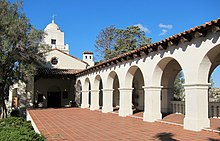
San Diego County has one of the highest counts of animal and plant species that appear on the
San Diego and its backcountry suffer from periodic wildfires. In October 2003, San Diego was the site of the
Neighborhoods
The City of San Diego recognizes 52 individual areas as Community Planning Areas.
- Selection of neighborhoods in San Diego
-
Gaslamp Quarter
For the most part, San Diego neighborhood boundaries tend to be understood by its residents based on geographical boundaries like canyons and street patterns.[101] The city recognized the importance of its neighborhoods when it organized its 2008 General Plan around the concept of a "City of Villages".[102]
Cityscape

San Diego was originally centered on the Old Town district, but by the late 1860s the focus had shifted to the bayfront, in the belief that this new location would increase trade. As the "New Town" – present-day Downtown – waterfront location quickly developed, it eclipsed Old Town as the center of San Diego.[42]
The development of skyscrapers over 300 feet (91 m) in San Diego is attributed to the construction of the
There are several new high-rises under construction, including two that exceed 400 feet (122 m) in height.
Demographics
| Census | Pop. | Note | %± |
|---|---|---|---|
| 1850 | 500 | — | |
| 1860 | 731 | 46.2% | |
| 1870 | 2,300 | 214.6% | |
| 1880 | 2,637 | 14.7% | |
| 1890 | 16,159 | 512.8% | |
| 1900 | 17,700 | 9.5% | |
| 1910 | 39,578 | 123.6% | |
| 1920 | 74,361 | 87.9% | |
| 1930 | 147,995 | 99.0% | |
| 1940 | 203,341 | 37.4% | |
| 1950 | 334,387 | 64.4% | |
| 1960 | 573,224 | 71.4% | |
| 1970 | 696,769 | 21.6% | |
| 1980 | 875,538 | 25.7% | |
| 1990 | 1,110,549 | 26.8% | |
| 2000 | 1,223,400 | 10.2% | |
| 2010 | 1,307,402 | 6.9% | |
| 2020 | 1,386,932 | 6.1% | |
| 2023 (est.) | 1,368,395 | [107] | −1.3% |
| Population History of Western U.S. Cities & Towns, 1850–1990[55] U.S. Decennial Census[108] 2010–2020[8] | |||
| Historical racial composition | 2020[109] | 2010[110] | 1990[111] | 1970[111] | 1940[111] |
|---|---|---|---|---|---|
| White (non-Hispanic) | 40.7% | 45.1% | 58.7% | 78.9%[a] | n/a |
| Hispanic or Latino (of any race) | 29.7% | 28.8% | 20.7% | 10.7%[a] | n/a |
Asian (non-Hispanic) |
17.6% | 15.9% | 11.8% | 2.2% | 1.0% |
Black or African American (non-Hispanic) |
6.6% | 6.7% | 9.4% | 7.6% | 2.0% |
2020
| Race / Ethnicity (NH = Non-Hispanic) | Pop 2000[112] | Pop 2010[113] | Pop 2020[114] | % 2000 | % 2010 | % 2020 |
|---|---|---|---|---|---|---|
White alone (NH)
|
603,892 | 589,702 | 565,128 | 49.36% | 45.10% | 40.75% |
Black or African American alone (NH)
|
92,830 | 82,497 | 77,542 | 7.59% | 6.31% | 5.59% |
Alaska Native alone (NH)
|
4,267 | 3,545 | 3,200 | 0.35% | 0.27% | 0.23% |
| Asian alone (NH) | 164,895 | 204,347 | 243,428 | 13.48% | 15.63% | 17.55% |
| Pacific Islander alone (NH) | 5,311 | 5,178 | 4,887 | 0.43% | 0.40% | 0.35% |
| Other race alone (NH) | 3,065 | 3,293 | 8,208 | 0.25% | 0.25% | 0.59% |
| Mixed race or Multiracial (NH) | 38,388 | 42,820 | 73,243 | 3.14% | 3.28% | 5.28% |
| Hispanic or Latino (any race) | 310,752 | 376,020 | 411,286 | 25.40% | 28.76% | 29.65% |
| Total | 1,223,400 | 1,307,402 | 1,386,932 | 100.00% | 100.00% | 100.00% |
2010
The city had a population of 1,307,402 according to the 2010 census, distributed over a land area of 372.1 square miles (963.7 km2).
The 2010 population represents an increase of just under 7% from the 1,223,400 people, 450,691 households, and 271,315 families reported in 2000.

As of January 2019[update], the San Diego City and County had the fifth-largest homeless population among major cities in the United States, with 8,102 people experiencing homelessness.[117] In the city of San Diego, 4,887 individuals were experiencing homelessness according to the 2020 count.[118] A recent article from The San Diego Union-Tribune by Blake Nelson, published on December 11, 2023, reports a notable decline in the homeless population in downtown San Diego, specifically in the urban core. According to data from the Downtown San Diego Partnership, the number of individuals living outside or in vehicles has reached a two-year low, standing at approximately 1,200 as of last month. The decrease is attributed to the implementation of the city's camping ban and the concerted efforts to establish new shelters. While enforcement has led to relatively few individuals being punished, the threat of legal consequences appears to have played a role in the reduction.[119]
In 2000 there were 451,126 households, out of which 30.2% had children under the age of 18 living with them, 44.6% were married couples living together, 11.4% had a female householder with no husband present, and 39.8% were non-families. Households made up of individuals account for 28.0%, and 7.4% had someone living alone who was 65 years of age or older. The average household size was 2.61, and the average family size was 3.30.
The U.S. Census Bureau reported that in 2000, 24.0% of San Diego residents were under 18, and 10.5% were 65 and over.[110] As of 2011[update] the median age was 35.6; more than a quarter of residents were under age 20 and 11% were over age 65.[120] Millennials (ages 26 through 42) constitute 27.1% of San Diego's population, the second-highest percentage in a major U.S. city.[121] The San Diego County regional planning agency, SANDAG, provides tables and graphs breaking down the city population into five-year age groups.[122]
In 2000, the
San Diego was named the ninth-most
The majority of San Diego's foreign-born population are born in Mexico, the Philippines, China and Vietnam.[130]
Economy

The largest sectors of San Diego's economy are
San Diego recorded aTop employers
According to the city's 2022 Annual Comprehensive Financial Report,[134] the top employers in the city are:
| Employer | No. of Employees |
|---|---|
| Naval Base San Diego | 41,321 |
| University of California, San Diego | 37,064 |
| Sharp Health Care | 18,839 |
| County of San Diego | 16,744 |
| Scripps Health | 13,787 |
| San Diego Unified School District | 13,559 |
| Qualcomm, Inc. | 11,546 |
| City of San Diego | 11,466 |
| Kaiser Permanente | 9,632 |
Northrop Grumman Corporation
|
6,075 |
Defense and military

The economy of San Diego is influenced by
San Diego hosts the largest naval fleet in the world:[138] In 2008 it was home to 53 ships, over 120 tenant commands, and more than 35,000 sailors, marines, Department of Defense civilian employees and contractors.[139] About 5 percent of all civilian jobs in the county are military-related, and 15,000 businesses in San Diego County rely on Department of Defense contracts.[139]

Military bases in San Diego include
The military infrastructure in San Diego is still growing and developing, with numerous military personnel stationed there, numbers of which are expected to rise. This plays a significant role in the city's economy, as of 2020[update], it provides roughly 25% of the GDP and provides 23% of the total jobs in San Diego.[141][142][143]
Tourism

Tourism is a major industry owing to the city's climate,
San Diego County hosted more than 32 million visitors in 2012; collectively they spent an estimated $8 billion. The visitor industry provides employment for more than 160,000 people.[148]
San Diego's cruise ship industry used to be the second-largest in California. Numerous cruise lines operate out of San Diego. However, cruise ship business has been in decline since 2008, when the Port hosted over 250 ship calls and more than 900,000 passengers. By 2016–2017, the number of ship calls had fallen to 90.[149]
Local sightseeing cruises are offered in San Diego Bay and Mission Bay, as well as whale-watching cruises to observe the migration of
International trade

San Diego's commercial port and its location on the
The city shares a 15-mile (24 km) border with Mexico that includes two border crossings. San Diego hosts the busiest international border crossing in the world, in the San Ysidro neighborhood at the

The
Historically tuna fishing and canning was one of San Diego's major industries,[157] although the American tuna fishing fleet is no longer based in San Diego. Seafood company Bumble Bee Foods is headquartered in San Diego, as was Chicken of the Sea until 2018.[158][159]
Companies

San Diego hosts several major producers of wireless cellular technology.
The
Real estate
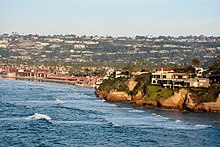
San Diego has high real estate prices. San Diego home prices peaked in 2005, and then declined along with the national trend. As of December 2010, prices were down 36 percent from the peak,
Consequently, San Diego has experienced negative net migration since 2004. A significant number of people have moved to adjacent Riverside County, commuting daily to jobs in San Diego, while others are leaving the area altogether and moving to more affordable regions.[178]
Government
Local government

The city is governed by a mayor and a nine-member city council. In 2006, its government changed from a
The members of the city council are each elected from single-member districts within the city. The mayor and city attorney are elected directly by the voters of the entire city. The mayor, city attorney, and council members are elected to four-year terms, with a two-term limit.[184] Elections are held on a non-partisan basis per California state law; nevertheless, most officeholders do identify themselves as either Democrats or Republicans. In 2007, registered Democrats outnumbered Republicans by about 7 to 6 in the city,[185] and Democrats currently (as of 2022[update]) hold an 8–1 majority in the city council. The current mayor, Todd Gloria, is a member of the Democratic Party.

San Diego is part of
Areas of the city immediately adjacent to San Diego Bay ("tidelands") are administered by the Port of San Diego, a quasi-governmental agency which owns all the property in the tidelands and is responsible for its land use planning, policing, and similar functions. San Diego is a member of the regional planning agency San Diego Association of Governments (SANDAG). Public schools within the city are managed and funded by independent school districts (see below).
After narrowly supporting Lyndon B. Johnson in 1964, San Diego provided majorities to all six Republican presidential candidates from 1968 to 1988. However, in more recent decades, San Diego has trended in favor of Democratic presidential candidates for president. George H. W. Bush in 1988 is the last Republican candidate to carry San Diego in a presidential election.
State and federal representation

In the
), respectively.In the California State Assembly, lying partially within the city of San Diego are the 77th, 78th, 79th, and 80th districts,[188] represented by Tasha Boerner (D), Chris Ward (D), Akilah Weber (D), and David Alvarez (D), respectively.
In the United States House of Representatives, San Diego County includes parts or all of California's 48th, 49th, 50th, 51st, and 52nd congressional districts,[189] represented by Darrell Issa (R), Mike Levin (D), Scott Peters (D), Sara Jacobs (D), and Juan Vargas (D) respectively.
Scandals

San Diego was the site of the 1912 San Diego free speech fight, in which the city restricted speech, vigilantes brutalized and tortured anarchists, and the San Diego Police Department killed a member of the Industrial Workers of the World (IWW).
In 1916,
Then-mayor
A 2002 scheme to underfund pensions for city employees led to the San Diego pension scandal. This resulted in the resignation of newly re-elected Mayor Dick Murphy[194] and the criminal indictment of six pension board members.[195] Those charges were finally dismissed by a federal judge in 2010.[196]

On November 28, 2005, U.S. Congressman
In 2005 two city council members,
In July 2013, three former supporters of mayor Bob Filner asked him to resign because of allegations of repeated sexual harassment.[202] Over the ensuing six weeks, 18 women came forward to publicly claim that Filner had sexually harassed them,[203] and multiple individuals and groups called for him to resign. Filner agreed to resign effective August 30, 2013, subsequently pleaded guilty to one felony count of false imprisonment and two misdemeanor battery charges, and was sentenced to house arrest and probation.[204][205]
Crime

Like most major cities, San Diego had a declining crime rate from 1990 to 2000. 1991 would mark the city's deadliest year, registering 179 homicides
According to
Education
Primary and secondary schools
Several adjacent school districts which are headquartered outside the city limits serve some schools within the city; these include the Poway Unified School District, Del Mar Union School District, San Dieguito Union High School District, and Sweetwater Union High School District. In addition, there are a number of private schools in the city.
Colleges and universities

According to education rankings released by the U.S. Census Bureau in 2017, 44.4% of San Diegans (city, not county) ages 25 and older hold bachelor's degrees, compared to 30.9% in the United States as a whole. The census ranks the city as the ninth-most educated city in the United States, based on these figures.[217]
The largest university in the area is the
Other public colleges and universities in the city include San Diego State University (SDSU) and the San Diego Community College District, which includes San Diego City College, San Diego Mesa College, and San Diego Miramar College.

Private non-profit colleges and universities in the city include the
There is one medical school in the city, the
Libraries
The city-run San Diego Public Library system is headquartered downtown and has 36 branches throughout the city.[219] The newest location is in Skyline Hills, which broke ground in 2015.[220] The libraries have had reduced operating hours since 2003 due to the city's financial problems. In 2006 the city increased spending on libraries by $2.1 million.[221] A new nine-story Central Library on Park Boulevard at J Street opened on September 30, 2013.[222]
In addition to the municipal public library system, there are nearly two dozen libraries open to the public run by other governmental agencies, and by schools, colleges, and universities.[223] Noteworthy are the Malcolm A. Love Library at San Diego State University, and the Geisel Library at the University of California, San Diego.
Culture

The culture of San Diego, California is influenced heavily by the mixing of
Many popular museums, such as the

The
The
Sports
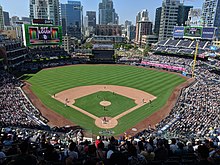
Sports in San Diego includes one
San Diego is home to the National Women's Soccer League (NWSL)'s San Diego Wave FC, National Lacrosse League (NLL)'s San Diego Seals (box lacrosse), Premier Lacrosse League (PLL)'s California Redwoods (field lacrosse), Major League Rugby (MLR)'s San Diego Legion, Major Arena Soccer League (MASL)'s San Diego Sockers, Indoor Football League (IFL)'s San Diego Strike Force, Pro Volleyball Federation (PVF)'s San Diego Mojo (women's), National Volleyball Association (NVA)'s San Diego Wild (men's), Ultimate Frisbee Association (UFA)'s San Diego Growlers (men's), and the Western Ultimate League (WUL)'s San Diego Super Bloom (women's).
Professional teams
The following teams compete at their sport's highest level of domestic competition.
- Bold indicates major professional league team.
- Italic indicates club or semi-pro team competing in its sport's highest level league, where the sport has no fully-professional domestic competition.
- ^ First season in San Diego
- ^ Average home game attendance
- ^ Original founding as a Minor League Baseball (MiLB) team: San Diego Padres (PCL)
- ^ Team began play in 2019 as Redwoods Lacrosse Club, a charter member of the PLL, which was a touring-only league of nomadic teams for its first five seasons. The league assigned teams to home markets beginning in 2024, with San Diego's Torero Stadium becoming the home of the Redwoods
- ^ Original founding. Current team is the 3rd San Diego Sockers iteration of highest-level professional indoor soccer, revived in 2009. Previous teams: San Diego Sockers (1978–1996) and San Diego Sockers (2001–2004)
- ^ The Sockers plan to move to Frontwave Arena (capacity 6,367), a newly constructed arena in the suburb of Oceanside in 2024[231]
- 1984)
- ^ Team was temporarily dormant for 2021 season due to effects of COVID-19 pandemic
- ^ 2001, 2006
- ^ Non-annual competition, no fixed schedule- matches held years apart on dates agreed upon between the defender and the challenger
- ^ 1987, 1988, 1992
Minor league teams
The following teams compete below their sport's highest level of domestic competition.
| Club | League | Tier[a] | Sport | Since[b] | Home venue | Attendance[c] |
|---|---|---|---|---|---|---|
| San Diego Gulls | AHL | 2 (NHL) | Ice hockey | 1966;[d] 2015[e] | Pechanga Arena | 6,953 (2022-23)[233] |
| San Diego Clippers | G-League
|
2 (NBA) | Basketball | 2024[234] | Frontwave Arena | |
| San Diego Surf Riders | MiLC | 2 (MLC) | Cricket | 2021 | Canyonside Park | |
| Albion San Diego | NISA | 3 (MLS & USLC) | Soccer | 1981;[f] 2019;[g] 2022[h] | Canyon Crest Academy |
- ^ Competition tier (parentheses indicate higher-level league(s)
- ^ First season in San Diego
- ^ Average home game attendance
- ^ Original founding. Current team is the 4th San Diego Gulls iteration of minor league professional ice hockey, revived in 2015. Previous teams: San Diego Gulls (1966–1974), San Diego Gulls (1990–1995) & San Diego Gulls (1995–2006)
- ^ Current AHL franchise was founded in 2000 as the Norfolk Admirals, later relocating to San Diego and assuming the Gulls name in 2015
- ^ Original founding as Albion SC youth academy
- ^ San Diego 1904 FC competed in the NISA from 2019 to 2021 before being absorbed into Albion San Diego in December 2021
- ^ First season as Albion San Diego following merger absorbing San Diego 1904 FC
College athletics
| Club | University | Enrollment | League | Primary conference |
|---|---|---|---|---|
| San Diego State Aztecs | San Diego State University | 35,723[235] (2022) | NCAA Division I (FBS) | Mountain West Conference |
| San Diego Toreros | University of San Diego | 8,815[236] (2022) | NCAA Division I (FCS) | West Coast Conference |
| UC San Diego Tritons | University of California, San Diego | 42,968[237] (2022) | NCAA Division I | Big West Conference |
| Cal State San Marcos Cougars | California State University, San Marcos | 14,311[238] (2022) | NCAA Division II | California Collegiate Athletic Association |
| Point Loma Sea Lions | Point Loma Nazarene University | 3,179[239] (2021) | NCAA Division II | Pacific West Conference |
| San Diego Christian Hawks | San Diego Christian College | 512 (2020) | NAIA | Golden State Athletic Conference |
| Saint Katherine Firebirds | University of Saint Katherine | 264 (2021) | NAIA | California Pacific Conference |
Annual sports events
| Event | Sport | Since | Organization | Current venue |
|---|---|---|---|---|
| Farmers Insurance Open | Golf | 1952 | PGA Tour | Torrey Pines Golf Course |
| Holiday Bowl | College football | 1978 | NCAA Division I (FBS) | Petco Park |
| Rady Children's Invitational | Basketball | 2023 | NCAA Division I | LionTree Arena
|
San Diego Open
|
Tennis | 1984 | Women's Tennis Association | Barnes Tennis Centre |
| San Diego Bayfair Cup | Hydroplane racing | 1964 | H1 Unlimited | Mission Bay |
| Rock 'n' Roll San Diego Marathon | Marathon | 1998 | Rock 'n' Roll Running Series | Balboa Park |
Media

Published within the city are the daily newspaper,
San Diego is also the headquarters of the national
San Diego led U.S. local markets with 69.6 percent broadband penetration in 2004 according to
San Diego's first television station was

Due to the ratio of U.S. and Mexican-licensed stations, San Diego is the largest
San Diego's television market is limited to only
counties are part of the Los Angeles market. (Sometimes, in the past, a missing network affiliate in the Imperial Valley would be available on cable TV from San Diego.) As a result, San Diego is the largest single-county media market in the United States.The radio stations in San Diego include nationwide broadcaster
Infrastructure
Transportation

With the automobile being the primary means of transportation for over 80 percent of residents, San Diego is served by a network of freeways and highways. This includes Interstate 5, which runs south to Tijuana and north to Los Angeles; Interstate 8, which runs east to Imperial County and the Arizona Sun Corridor; Interstate 15, which runs northeast through the Inland Empire to Las Vegas and Salt Lake City; and Interstate 805, which splits from I-5 near the Mexican border and rejoins I-5 at Sorrento Valley.
Major state highways include

The stretch of SR 163 that passes through Balboa Park is San Diego's oldest freeway, dating back to 1948 when it was part of US 80 and US 395. It has been called one of America's most beautiful parkways.[245]
San Diego's roadway system provides an extensive network of cycle routes. Its dry and mild climate makes cycling a convenient year-round option; however, the city's hilly terrain and long average trip distances make cycling less practicable. Older and denser neighborhoods around the downtown tend to be oriented to utility cycling. This is partly because the grid street patterns are now absent in newer developments farther from the urban core, where suburban-style arterial roads are much more common. As a result, the majority of cycling is recreational.
San Diego is served by the
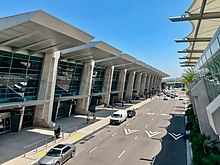
The city has two major commercial airports within or near its city limits. Downtown

Recent regional transportation projects have sought to mitigate congestion, including improvements to local freeways, expansion of San Diego Airport, and doubling the capacity of the cruise ship terminal. Freeway projects included expansion of Interstates 5 and 805 around "The Merge" where these two freeways meet, as well as expansion of Interstate 15 through North County, which includes new high-occupancy-vehicle (HOV) "managed lanes". A tollway (the southern portion of SR 125, known as the South Bay Expressway) connects SR 54 and Otay Mesa, near the Mexican border. According to an assessment in 2007, 37 percent of city streets were in acceptable condition. However, the proposed budget fell $84.6 million short of bringing streets up to an acceptable level.[257] Expansion at the port has included a second cruise terminal on Broadway Pier, opened in 2010. Airport projects include the expansion of Terminal Two.[258]
Utilities
Water is supplied to residents by the Water Department of the City of San Diego. The city receives most of its water from the Metropolitan Water District of Southern California, which brings water to the region from the Sacramento and San Joaquin rivers, via the state project and the Colorado River, via the Colorado Aqueduct.[259]
Gas and electric utilities are provided by
Street lights
In the mid-20th century the city had
In 2011, the city announced plans to upgrade 80% of its street lighting to new energy-efficient lights that use
In 2014, San Diego announced plans to become the first U.S. city to install cyber-controlled street lighting, using an "intelligent" lighting system to control 3,000
Notable people
Sister cities
San Diego's
 Alcalá de Henares, Spain (est. 1982)
Alcalá de Henares, Spain (est. 1982) Campinas, Brazil (est. 1995)
Campinas, Brazil (est. 1995) Cavite City, Philippines (est. 1969)
Cavite City, Philippines (est. 1969) Edinburgh, Scotland (est. 1977)
Edinburgh, Scotland (est. 1977) Jalalabad, Afghanistan (est. 2004)
Jalalabad, Afghanistan (est. 2004) Jeonju, South Korea (est. 1983)
Jeonju, South Korea (est. 1983) León, Mexico (est. 1969)
León, Mexico (est. 1969) Panama City, Panama (est. 2015)
Panama City, Panama (est. 2015) Perth, Australia (est. 1986)
Perth, Australia (est. 1986) Taichung, Taiwan (est. 1983)
Taichung, Taiwan (est. 1983) Tema, Ghana (est. 1976)
Tema, Ghana (est. 1976) Tijuana, Mexico (est. 1993)
Tijuana, Mexico (est. 1993) Vladivostok, Russia (est. 1991)
Vladivostok, Russia (est. 1991) Warsaw, Poland (est. 1996)
Warsaw, Poland (est. 1996) Yantai, China (est. 1985)
Yantai, China (est. 1985) Yokohama, Japan (est. 1957)
Yokohama, Japan (est. 1957)
See also
- USS San Diego, 4 ships
Notes
References
- ^ "California City Nicknames List". www.seecalifornia.com. Retrieved December 29, 2020.
- ^ "California Cities by Incorporation Date". California Association of Local Agency Formation Commissions. Archived from the original (Word) on November 3, 2014. Retrieved August 25, 2014.
- ^ "City of San Diego City Charter, Article XV" (PDF). City of San Diego. Retrieved November 5, 2014.
- ^ "Office of the City Attorney". The City of San Diego. November 6, 2015. Retrieved December 14, 2016.
- ^ "City Council Offices". City of San Diego. Retrieved December 10, 2014.
- ^ "2019 U.S. Gazetteer Files". United States Census Bureau. Retrieved July 1, 2020.
- ^ a b "San Diego: Geography and Climate". city-data.com. Retrieved October 16, 2014.
- ^ a b c "QuickFacts: San Diego city, California". census.gov. United States Census Bureau. Retrieved January 22, 2023.
- ^ "List of 2020 Census Urban Areas". census.gov. United States Census Bureau. Retrieved January 8, 2023.
- ^ "2020 Population and Housing State Data". United States Census Bureau. Retrieved August 22, 2021.
- ^ "Total Gross Domestic Product for San Diego-Carlsbad, CA (MSA)". U.S. Bureau of Economic Analysis.
- ^ "ZIP code(tm) Lookup". United States Postal Service. Retrieved November 19, 2014.
- ^ "City of San Diego". Geographic Names Information System. United States Geological Survey, United States Department of the Interior. Retrieved October 16, 2014.
- ^ "QuickFacts: San Diego County, California". census.gov. United States Census Bureau. Retrieved January 22, 2023.
- ^ McGrew, Clarence Alan (1922). City of San Diego and San Diego County: the birthplace of California. American Historical Society. Retrieved July 23, 2011.
- ^ America: metropolitan areas. World Gazetteer. 2011. Archived from the original on September 30, 2007. Retrieved February 19, 2012.
- ^ "San Diego Int'l Airport will dig up the runway every night for a year". San Diego Union-Tribune. November 20, 2017. Retrieved January 26, 2021.
- ^ a b Mills, James (October 1967). "San Diego...Where California Began". Journal of San Diego History. 13 (4). Archived from the original on June 14, 2011. Retrieved February 17, 2017.
- ^ a b c d Mogilner, Geoffrey. "Cosoy: Birthplace of New California". San Diego History Center | San Diego, CA | Our City, Our Story. Retrieved August 27, 2020.
- ^ "San Diego in Kumiai - English-Kumiai Dictionary | Glosbe". glosbe.com. Retrieved November 17, 2023.
- ^ "Pushuyi in Spanish - Luiseno-Spanish Dictionary | Glosbe". glosbe.com. Retrieved November 17, 2023.
- OCLC 745176510.
- ISBN 978-1-888691-17-7.
The Kumeyaay could have derived from the San Dieguito or they may have arrived from the desert around 1000 C.E.
- ^ OCLC 1135205590.
He created a sequence of cultural periods... the San Dieguito Complex and La Jolla Complex... suggested that... [they were] mutually exclusive and not associated with the ancestral populations of the contemporary Kumeyaay. The problem with Rogers' hypothesis is that it did not account for cultural evolution... Rogers' theories were, and continue to be, a popular paradigm... At the end of his career, Rogers re-evaluated his original conclusions regarding the cultural groups he had established...
- ^ a b "Kosa'aay (Cosoy) History". www.cosoy.org. Retrieved August 27, 2020.
- ^ "San Diego Historical Society". Sandiegohistory.org. Archived from the original on May 5, 2009. Retrieved March 12, 2011.
- ^ Pourade, Richard F. 1960. The History of San Diego: The Explorers. Union-Tribune Publishing Company, San Diego.
- ^ Ide, Arthur Frederick (Fall 1976). "San Diego: The Saint and the City". Journal of San Diego History. 22 (4).
- ^ "San Diego Historical Society:Timeline of San Diego history". Sandiegohistory.org. Archived from the original on December 24, 2015. Retrieved May 4, 2011.
- ^ Carrico, Richard. "Sociopolitical Aspects of the 1775 Revolt at Mission San Diego de Alcala". San Diego History Center | San Diego, CA | Our City, Our Story. Retrieved August 27, 2020.
- ^ "Keyfacts". missionscalifornia.com. Archived from the original on June 10, 2010. Retrieved July 1, 2010.
- ^ "Mission San Diego". Mission San Diego. Retrieved July 1, 2010.
- ^ "National Park Service, National Historical Landmarks Program: San Diego Presidio". Tps.cr.nps.gov. October 10, 1960. Archived from the original on July 21, 2011. Retrieved May 4, 2011.
- ^ "Timeline of San Diego History | San Diego History Center". December 24, 2015. Archived from the original on December 24, 2015. Retrieved August 7, 2018.
- ^ Connolly, Mike. "Kumeyaay – The Mexican Period". kumeyaay.com.
- ISBN 978-0-07-004224-7.
- ^ Griswold del Castillo, Richard (Winter 2003). "The U.S.-Mexican War in San Diego, 1846–1847". San Diego Historical Society Quarterly.
- ^ Griswold de Castillo 1990, p. 39
- ^ "A History of San Diego Government". Office of the City Clerk. City of San Diego. Archived from the original on May 5, 2014. Retrieved May 27, 2014.
- ^ "City of San Diego website". Sandiego.gov. Archived from the original on October 11, 2007. Retrieved July 1, 2010.
- ^ Basil C. Pearce, "The Jackass Mail—San Antonio and San Diego Mail Line", San Diego Historical Society Quarterly, Spring 1969, Volume 15, Number 2
- ^ a b Engstrand 2005, p. 80
- ^ Hall, Matthew T. (February 8, 2012). "100 years ago, San Diego banned free speech". San Diego Union-Tribune. Retrieved July 9, 2021.
- ^ Dotinga, Randy (March 15, 2011). "When San Diego Had Its Own Big Labor Clash". Voice of San Diego. Retrieved July 9, 2021.
- ^ Waller, Tom (April 2, 1992). "The Wobblies and San Diego's shame | San Diego Reader". San Diego Reader. Retrieved July 9, 2021.
- ^ "Shady Ladies in the "Stingaree District" When The Red Lights Went Out in San Diego". San Diego History Center. Archived from the original on October 24, 2005. Retrieved March 8, 2011.
- ^ "Balboa Park future is full of repair jobs". The San Diego Union-Tribune. March 18, 2015. Archived from the original on March 18, 2015. Retrieved August 7, 2018.
- ^ Marjorie Betts Shaw. "The San Diego Zoological Garden: A Foundation to Build on". Journal of San Diego History. 24 (3, Summer 1978). Retrieved May 4, 2011.
- ^ "CHAPTER 5: A Fiesta – Re-living the Days of the Dons | San Diego History Center". March 4, 2016. Archived from the original on March 4, 2016. Retrieved August 7, 2018.
- ^ Perry, Tony (March 5, 2014). "Balboa Park centennial event organizers end efforts". Los Angeles Times. Retrieved April 8, 2014.
- ^ "Historic California Posts: Fort Rosecrans". California State Military Museum. Archived from the original on July 14, 2007. Retrieved November 26, 2012.
- ^ University of San Diego: Military Bases in San Diego Archived April 11, 2007, at the Wayback Machine
- ^ a b Gerald A. Shepherd. "When the Lone Eagle returned to San Diego". Journal of San Diego History. 40 (s. 1 and 2, Winter 1992). Retrieved May 4, 2011.
- ^ "Consolidated Aircraft/Convair Online Exhibition". San Diego Air & Space Museum. Retrieved September 22, 2014.
- ^ a b Moffatt, Riley. Population History of Western U.S. Cities & Towns, 1850–1990. Lanham: Scarecrow, 1996, 54.
- ^ Naomi Baumslag, Murderous Medicine: Nazi Doctors, Human Experimentation, and Typhus, 2005, p.207
- ^ Amy Stewart (April 25, 2011). "Where To Find The World's Most 'Wicked Bugs': Fleas". National Public Radio.
- ^ Russell Working (June 5, 2001). "The trial of Unit 731". The Japan Times.
- ^ "Milken Institute". Milken Institute. Retrieved July 1, 2010.
- ^ "San Diego History Center Honors San Diego's Tuna Fishing Industry at Annual Gala". San Diego History Center. Retrieved September 1, 2012.
- ISSN 0022-4383.
- ^ Lechowitzky, Irene (November 19, 2006). "It's the old country, with new condos". Los Angeles Times. Retrieved September 1, 2012.
- ^ Crawford, Richard (June 20, 2009). "San Diego once was 'Tuna Capital of World'". San Diego Union Tribune. Retrieved September 1, 2012.[permanent dead link]
- S2CID 154024558.
- ^ Marshall, Monte. "The Geology and Tectonic Setting of San Diego Bay, and That of the Peninsular Ranges and Salton Trough, Southern California". Phil Farquharson. Retrieved July 13, 2012.
- ^ "Canyon Enhancement Planning Guide" (PDF). San Diego Canyonlands. p. 7. Archived from the original (PDF) on June 20, 2013. Retrieved July 20, 2012.
- ISBN 9780899975153. Retrieved May 4, 2011.
- ^ a b "Expeditions by Sea" The Explorers. Trans. Richard F. Pourade. La Jolla: Copley, 1960. 64–72.
- ^ Janet R. Fireman and Manuel P. Servín, "Miguel Costansó: California's Forgotten Founder." California Historical Society Quarterly, vol. 49, no. 1, March 1970, pp. 3–19.
- ^ "NOAA NCEI U.S. Climate Normals Quick Access".
- . Retrieved July 9, 2013.
- ^ "Atlas of the Biodiversity of California" (PDF). March 31, 2010. Archived from the original (PDF) on March 31, 2010. Retrieved August 7, 2018.
- ^ Francisco Pugnaire and Fernando Valladares eds. Functional Plant Ecology. 2d ed. 2007. p.287.
- ^ Michael Allaby, Martyn Bramwell, Jamie Stokes, eds. Weather and Climate: An Illustrated Guide to Science. 2006. p.182.
- ^ Michalski, Greg et al. First Measurements and Modeling of ∆17O in atmospheric nitrate Archived July 24, 2013, at the Wayback Machine. Geophysical Research Letters, Vol. 30, No. 16. p.3. 2003.
- ^ "UCSD". Meteora.ucsd.edu. May 14, 2010. Archived from the original on June 13, 2010. Retrieved July 1, 2010.
- The Weather Channel. Archived from the originalon May 2, 2009. Retrieved April 22, 2009.
- The Weather Channel. Archived from the originalon June 4, 2011. Retrieved April 22, 2009.
- ^ Lee, Mike (June 18, 2011). "Is global warming changing California Current?". U-T (San Diego Union Tribune). Retrieved June 20, 2011.
- ^ "San Diego's average rainfall set to lower level". San Diego Union-Tribune. March 16, 2011. Retrieved April 12, 2011.
- ^ Rowe, Peter (December 13, 2007). "The day it snowed in San Diego". San Diego Union Tribune. Archived from the original on August 10, 2011. Retrieved May 4, 2011.
- ^ "Storm brings major snowfall to East County communities". Fox 5. Fox 5 Digital Team. February 21, 2019. Retrieved February 27, 2021.
- ^ Conner, Glen. History of weather observations San Diego, California 1849–1948. Climate Database Modernization Program, NOAA's National Climatic Data Center. pp. 7–8.
- ^ "NowData – NOAA Online Weather Data". National Oceanic and Atmospheric Administration. Retrieved June 14, 2021.
- ^ "Summary of Monthly Normals 1991–2020". National Oceanic and Atmospheric Administration. Archived from the original on August 8, 2023. Retrieved June 14, 2021.
- ^ "San Diego/Lindbergh Field CA Climate Normals 1961–1990". National Oceanic and Atmospheric Administration. Archived from the original on August 8, 2023. Retrieved July 18, 2020.
- ^ Pryde, Philip R. 2014. "The Nature of the County: San Diego's Climate, Vegetation, and Wildlife". In: San Diego: An Introduction to the Region, by Philip R. Pryde, pp. 29–45. 5th ed. Sunbelt Publications, San Diego.
- S2CID 40769609. 1572-9761.
- ^ Strömberg, Nicklas; Hogan, Michael (November 29, 2008). "Torrey Pine: Pinus torreyana". GlobalTwitcher. Archived from the original on January 16, 2009. Retrieved April 22, 2009.
- ^ "Tecolote Canyon Natural Park & Nature Center". The City of San Diego. Retrieved April 22, 2009.
- ^ "Marian Bear Memorial Park". The City of San Diego. Archived from the original on May 5, 2013. Retrieved April 22, 2009.
- ^ a b "SignOnSanDiego.com > News > Politics – White House seeks limits to species act". October 21, 2012. Archived from the original on October 21, 2012. Retrieved August 7, 2018.
- ^ "San Diego County Bird Atlas Project". San Diego Natural History Museum. Retrieved June 20, 2014.
- ^ "Corpus Christi Recognized as Birdiest City". Corpus Christi Daily. December 2004. Archived from the original on October 25, 2007. Retrieved April 13, 2011.
- ^ "Corpus Christi remains 'birdiest city in America'". Corpus Christi Convention and Visitors Bureau. June 25, 2008. Retrieved April 13, 2011.
- S2CID 216142119.
- ^ "CalFire website". Fire.ca.gov. Archived from the original on July 11, 2010. Retrieved July 1, 2010.
- S2CID 27215815. Archived from the originalon December 27, 2008. Retrieved December 15, 2008.
- ^ "City of San Diego Community Planning Areas". Sandiego.gov. Archived from the original on May 6, 2011. Retrieved May 4, 2011.
- ^ "How San Ysidro Became Part of the City of San Diego". Voice of San Diego. May 8, 2019. Retrieved December 9, 2019.
- .
- ^ Roger Showley (April 18, 2010). "City, SANDAG win planning awards". San Diego Union-Tribune. Retrieved May 4, 2011.
- ^ "San Diego Timeline Diagram". Skyscraper Source Media. Retrieved May 31, 2011.
- ^ "One America Plaza". Emporis.com. Archived from the original on February 23, 2015. Retrieved May 16, 2009.
- ^ "Airport Land Use Compatibility Plan for San Diego International Airport" (PDF). San Diego County Regional Airport Authority. October 4, 2004. pp. 51–52. Archived from the original (PDF) on June 30, 2014. Retrieved May 16, 2009.
- ^ Bergman, Heather (June 27, 2005). "San Diego's skyline grows up: residential towers filling some of the missing 'tools' as office projects are nearing completion". San Diego Business Journal. The Heritage Group. Archived from the original on February 4, 2013. Retrieved August 28, 2012.
- ^ "State's Population Decline Slows While Housing Grows Per New State Demographic Report" (PDF). dof.ca.gov (Press release). Retrieved September 13, 2023.
- ^ United States Census Bureau. "Census of Population and Housing". Retrieved April 27, 2015.
- ^ "2020 Racial and Ethnic Statistics". United States Census Bureau. Retrieved January 21, 2022.
- ^ a b c d "San Diego (city) QuickFacts from the US Census Bureau". US Census Bureau. Archived from the original on August 2, 2012. Retrieved February 14, 2010.
- ^ a b c Gibson, Campbell; Jung, Kay. "Historical Census Statistics On Population Totals By Race, 1790 to 1990, and By Hispanic Origin, 1970 to 1990, For Large Cities And Other Urban Places In The United States". U.S. Census Bureau. Retrieved February 18, 2019.
- ^ "P004: Hispanic or Latino, and Not Hispanic or Latino by Race – 2000: DEC Summary File 1 – San Diego city, California". United States Census Bureau. Retrieved January 26, 2024.
- ^ "P2: Hispanic or Latino, and Not Hispanic or Latino by Race – 2010: DEC Redistricting Data (PL 94-171) – San Diego city, California". United States Census Bureau. Retrieved January 26, 2024.
- ^ "P2: Hispanic or Latino, and Not Hispanic or Latino by Race – 2020: DEC Redistricting Data (PL 94-171) – San Diego city, California". United States Census Bureau. Retrieved January 26, 2024.
- ^ "Census: 1,307,402 Live in San Diego". Voice of San Diego. March 8, 2011. Archived from the original on December 28, 2012. Retrieved May 4, 2011.
- ^ "San Diego, CA Census Profile". USA Today. March 8, 2011. Archived from the original on March 11, 2011. Retrieved March 12, 2011.
- ^ "2019 AHAR: Part 1 - PIT Estimates of Homelessness in the U.S. - HUD Exchange". www.hudexchange.info. United States Department of Housing and Urban Development. January 2020.
- ^ "Homelessness on City of San Diego Streets Drops by 12 Percent in Annual Count". City of San Diego Official Website. April 28, 2020. Archived from the original on November 2, 2020. Retrieved November 3, 2020.
- ^ Nelson, Blake (December 12, 2023). "The homeless population downtown just hit a two-year low. The result is a mixed bag". San Diego Union-Tribune. Retrieved December 16, 2023.
- ^ "Population". City of San Diego. March 1, 2011. Archived from the original on March 2, 2016. Retrieved March 2, 2016.
- ^ Lipkin, Michael (March 3, 2016). "San Diego Has Nation's Second-Largest Millennial Population". San Diego Business Journal. Retrieved March 4, 2016.
- ^ "SANDAG document". Retrieved July 1, 2010.[permanent dead link]
- ^ a b "San Diego city, California". United States Census Bureau. 2000. Archived from the original on February 12, 2020. Retrieved April 22, 2009.
- ^ Clemence, Sara (October 28, 2005). "Richest Cities in the U.S." Forbes. Retrieved April 22, 2009.
- ^ "Population and Housing Estimates" (PDF). SANDAG: Profile Warehouse. 2008. Archived from the original (PDF) on June 14, 2007. Retrieved April 22, 2009.
- ^ Divya - NerdWallet.com (May 30, 2013). "NerdWallet names America's most gay-friendly cities | San Diego Gay and Lesbian News". Sdgln.com. Retrieved June 15, 2013.
- ^ "San Diego State University | Campus Pride | The leading national organization for LGBT student leaders and campus groups". Campus Pride. Retrieved June 15, 2013.
- ^ Major U.S. metropolitan areas differ in their religious profiles, Pew Research Center
- ^ "America's Changing Religious Landscape". Pew Research Center: Religion & Public Life. May 12, 2015.
- ^ "Our immigrant story". go.sandiegouniontribune.com.
- ^ "City of San Diego website: Economic Development". Sandiego.gov. Archived from the original on May 6, 2011. Retrieved April 11, 2011.
- San Diego Union-Tribune. Retrieved April 22, 2009.
- ^ a b c San Diego DataUSA
- ^ City of San Diego, California Annual Comprehensive Financial Report, Year ended June 30, 2021, page 302
- ^ Ronald D. White (July 3, 2011). "Full steam ahead for Nassco shipyard in San Diego". Los Angeles Times. Retrieved September 1, 2012.
- ^ "S.D. companies dominate defense industry rankings". San Diego Union Tribune. August 11, 2010. Retrieved September 1, 2012.
- ^ "San Diego" (PDF). San Diego Convention Center Corporation. City of San Diego. Archived from the original (PDF) on May 5, 2012. Retrieved September 1, 2012.
Several major defense contractors are also headquartered in San Diego, including General Atomics, Cubic and NASSCO.
- ^ Eric Terrill; Julia Thomas, Anne Footer. "Submitted in response to Federal Funding Opportunity: FY 2011 Implementation of the U.S. Integrated Ocean Observing System (IOOS)" (PDF). Southern California Coastal Ocean Observing System. University of California, San Diego. Archived from the original (PDF) on August 26, 2011. Retrieved April 21, 2011.
- ^ Tierney Plumb (August 24, 2012). "San Diego companies lead state in '11 defense contracts". San Diego Daily Transcript. Retrieved September 1, 2012.
San Diego houses the largest concentration of military in the world; it is the homeport to more than 60 percent of the ships of the U.S. Pacific Fleet and more than one-third of the combat power of the U.S. Marine Corps.
- San Diego Union-Tribune. October 10, 2019. Retrieved February 25, 2021.
- ^ "Welcome to Naval Base San Diego". Cnic.navy.mil. Retrieved February 25, 2021.
- ^ "2020 San Diego Military Economic Impact Report" (PDF). Sdmac.org. Archived from the original (PDF) on March 12, 2021. Retrieved February 25, 2021.
- ^ Calvert, Kyla (July 15, 2010). "Arizona Visitors Still Flocking To San Diego Beaches". San Diego, CA: KPBS. Retrieved May 28, 2021.
- ^ Dickerman, Sara (May 25, 2012). "Beyond San Diego's Surf and Sun: Suds". The New York Times. Retrieved May 30, 2012.
- ^ "San Diego Kicks Off First-Ever Beer Week". The Full Pint. August 17, 2009. Retrieved May 30, 2012.
- ISBN 978-0981622231.
- ^ "San Diego Tourism Industry Research". San Diego Tourism Authority. 2012. Archived from the original on December 21, 2016. Retrieved July 16, 2013.
- ^ Lori Weisberg (August 10, 2017). "Is San Diego cruise business making a comeback?". San Diego Union-Tribune. Retrieved December 21, 2017.[permanent dead link]
- ^ "Whale Watching in San Diego". InTheCity-SanDiego Tourism. 2011–2012. Archived from the original on February 7, 2012. Retrieved February 19, 2012.
- ^ Sisson, Paul (September 3, 2015). "The big hook-up: Sportfishing's superb season". San Diego Union-Tribune. Retrieved September 8, 2015.
- ^ "City of San Diego:Foreign Trade Zone". Archived from the original on May 2, 2011. Retrieved April 28, 2011.
- ^ "Number of border crossings stabilizes". San Diego Union-Tribune. July 11, 2010. Retrieved April 28, 2011.
- ^ "SANDAG: Otay Mesa Port of Entry Southbound Truck Route Improvements" (PDF). sandiegohealth.org. Retrieved April 28, 2011.
- ^ "Port of San Diego:10th Avenue Marine Terminal". Archived from the original on May 5, 2011. Retrieved April 28, 2011.
- ^ "National ranking of California ports by cargo volume". San Diego Daily Transcript. March 21, 2011. Retrieved April 28, 2011.
- ^ "Tuna! Celebrating San Diego's Famous Fishing Industry". San Diego History Center. Retrieved September 1, 2012.
- ^ Roger Showley (January 29, 2013). "Bumble Bee may buzz downtown: The tuna company considers high-profile move from Kearny Mesa". San Diego Union Tribune. Archived from the original on July 24, 2013. Retrieved February 3, 2013.
- ^ "Chicken of the Sea Moves North American HQ from S.D. to El Segundo". San Diego Business Journal. May 3, 2018. Retrieved September 7, 2021.
- ^ "City Of San Diego Largest Employers". San Diego Daily Transcript. Retrieved April 22, 2009.
- ^ Glazer, Joyce (October 6, 2008). "San Diego-based LG Mobile Phones donated $250,000 to the VH1 Save the Music Foundation". Entrepreneur Media. Archived from the original on July 24, 2013. Retrieved March 18, 2011.[dead link]
- ^ Desjardins, Doug (January 11, 2010). "Kyocera International to Get New Leader". San Diego Business Journal. Archived from the original on July 27, 2011. Retrieved March 20, 2011.[dead link]
- ^ "Novatel website: Corporate headquarters". Archived from the original on April 17, 2011. Retrieved April 11, 2011.
- ^ Allen, Mike (September 20, 2010). "ESET Polishes the Apple, Now Protects Macs". San Diego Business Journal. Retrieved March 20, 2011.
- ^ "iHub San Diego" (PDF). California Governor's Office of Economic Development. Archived from the original (PDF) on July 18, 2011. Retrieved April 7, 2011.
- ^ Doyle, Monica (February 5, 2004). "UCSD Extension Awarded A $150,000 Grant For Biotechnology Collaboration With Israel". UCSD News. Retrieved April 22, 2009.
- ^ Bradley J. Fikes (February 12, 2013). "Report: San Diego 2nd in life sciences". San Diego Union Tribune. Archived from the original on July 24, 2013. Retrieved February 15, 2013.
- ^ "SDBN.org". SDBN.org. Archived from the original on July 15, 2012. Retrieved July 1, 2010.
- S2CID 154435216.
- ^ Bigelow, Bruce V. "San Diego's Life Sciences CROs—The Map of Clinical Research Organizations", "Xconomy", San Diego, January 27, 2010.
- ^ Freeman, Mike (December 29, 2010). "Housing Prices Fall Again, Index Says". San Diego Union Tribune. Retrieved May 4, 2011.
- ^ Showley, Roger (May 9, 2010). "Realty Revival". San Diego Union Tribune. Retrieved May 4, 2011.
- ^ "Median price of home hits $520K in San Diego". FOX5 San Diego. May 8, 2015. Retrieved January 29, 2016.
- ^ Cox, Wendell (January 28, 2009). "New Survey: Improving Housing Affordability – But Still a Way to Go". NewGeography. Retrieved June 20, 2013.
- ^ "The San Diego Real Estate Market is Slowing". February 22, 2023.
- ^ Coakley, Amber (July 12, 2023). "San Diego among cities where majority of homes cost over $1M: study". fox5sandiego.com. Archived from the original on July 13, 2023. Retrieved September 5, 2023.
- ^ De La Fe, Rocio (July 13, 2023). "Report: Nearly 60% of homes for sale in San Diego are over $1 million". cbs8.com. Archived from the original on July 14, 2023. Retrieved September 5, 2023.
- San Diego Union-Tribune. Archived from the originalon August 14, 2016. Retrieved May 16, 2021.
- ^ "San Diego City website". Sandiego.gov. Archived from the original on July 20, 2010. Retrieved July 1, 2010.
- ^ Grant Martin (April 10, 2011). "A close look at 'sanctuary cities'". The Arizona Republic. Retrieved January 13, 2013.
These communities – called "sanctuary cities" by both critics and defenders – are home to many of the estimated 10.8 million illegal immigrants in the U.S. and include Austin, New York City, San Diego and Minneapolis.
- ^ John Coté (May 18, 2010). "Sheriff asks to opt out of federal immigration program". San Francisco Chronicle. Archived from the original on May 11, 2013. Retrieved January 13, 2013.
The program is already in place for numerous counties in California that have sanctuary cities, including Los Angeles, San Diego and Alameda.
- ^ Ruxandra Guidi. "'Secure Communities' Program Comes Under Fire". KPBS. Retrieved January 13, 2013.
- ^ Rosiak, Luke (July 22, 2013). "EXography: 19 U.S. cities have proportionately bigger workforces than bankrupted Detroit". Washington Examiner. District of Columbia. Archived from the original on May 24, 2015. Retrieved May 16, 2015.
- ^ "San Diego City website". Sandiego.gov. Archived from the original on May 6, 2010. Retrieved July 1, 2010.
- ^ "Voter Registration in the City of San Diego" (PDF). San Diego Office of the City Clerk. August 1, 2007. Archived from the original (PDF) on March 25, 2009. Retrieved April 22, 2009.
- ^ "Registrar of voters: Maps of individual supervisorial districts". County of San Diego. Retrieved May 31, 2011.
- ^ "Communities of Interest – City". California Citizens Redistricting Commission. Archived from the original on October 23, 2015. Retrieved September 27, 2014.
- ^ "Communities of Interest — City". California Citizens Redistricting Commission. Archived from the original on October 23, 2015. Retrieved September 28, 2014.
- ^ "Communities of Interest – City". California Citizens Redistricting Commission. Archived from the original on September 30, 2013. Retrieved September 27, 2014.
- ISBN 978-1-56025-675-5.
- ^ Horstman, Barry (December 6, 1987). "Man About Town: San Diego's Ex-Mayor Roger Hedgecock Hasn't Let His Felony Conviction Get Him Down. But This Week, the Past May Catch Up With Him". Los Angeles Times. Retrieved April 2, 2011.
- ^ Abrahamson, Alan (February 2, 1992). "Bailiff's Bias in Hedgecock Trial Disclosed". Los Angeles Times. Retrieved April 3, 2011.
- ^ "Hedgecock has clean slate; judge erases felony record". San Diego Union-Tribune. January 1, 1991. Retrieved June 1, 2011.
- ^ "San Diego's Widening Pension Woes". Bloomberg BusinessWeek. June 13, 2005. Archived from the original on June 6, 2005. Retrieved July 1, 2010.
- ^ Strumpf, Daniel (June 15, 2005) San Diego's Pension Scandal for Dummies, San Diego City Beat via Internet Archive. Retrieved April 3, 2011.
- ^ Hall, Matthew T. (April 8, 2010). "Five cleared in San Diego pension case". San Diego Union-Tribune. Retrieved July 1, 2010.
- ^ "Cunningham Moving to Arizona Prison". The Washington Post. January 5, 2007. Retrieved February 3, 2010.
- ^ Moran, Greg & Thornton, Kelly (July 19, 2005). "Councilmen Guilty". San Diego Union-Tribune. Archived from the original on August 9, 2011. Retrieved April 6, 2011.
- ^ "Ralph Inzunza Goes to Prison (Soon)". NBC San Diego. January 20, 2012. Retrieved July 8, 2012.
- ^ "Appeals Court opinion, Sept. 1, 2009" (PDF). Retrieved July 1, 2010.
- ^ Greg Moran (October 14, 2010). "Seven Years Later, Zucchet Cleared". San Diego Union-Tribune. Retrieved April 6, 2011.
- ^ Filner apologizes, gets professional help, San Diego Union Tribune, July 11, 2013
- ^ Lah, Kyung (August 21, 2013). "Another sex harassment accusation for San Diego Mayor Bob Filner". CNN. Retrieved August 22, 2013.
- ^ "San Diego Mayor Resigns in Sexual Harassment Scandal". NY Times. August 23, 2013. Retrieved August 23, 2013.
- ^ "Ex-San Diego mayor Bob Filner pleads guilty to 3 charges". USA Today. October 15, 2013. Retrieved October 15, 2013.
- ^ Landsberg, Mitchell (January 2, 1992). "Once Again, Homicide Records Fall in Many Big Cities With Graphic". Associated Press. Retrieved January 1, 2020.
- ^ Burke, Cynthia (April 2014). "Thirty Years of Crime in the San Diego Region: 1984 through 2013" (PDF). Archived from the original (PDF) on March 4, 2021. Retrieved January 1, 2020.
- ^ Platte, Mark (December 5, 1991). "Violent Crime Is Up Sharply in San Diego". Los Angeles Times. Retrieved December 25, 2020.
- ^ "San Diego Historical Crime Actuals" (PDF). 1950–2020. Retrieved December 25, 2020.
- ^ "SDPD Historical Crime Actuals 1950–2006" (PDF). San Diego Police Department. April 14, 2006. Archived from the original (PDF) on March 25, 2009. Retrieved April 22, 2009.
- ^ "SDPD Historical Crime Rates Per 1,000 Population 1950–2006" (PDF). San Diego Police Department. April 14, 2006. Archived from the original (PDF) on March 25, 2009. Retrieved April 22, 2009.
- ^ San Diego Union-Tribune. Retrieved April 22, 2009.
- ^ "Crime Report for San Diego, California". Archived from the original on June 15, 2011. Retrieved March 23, 2011.
- ^ "California – Offenses Known to Law Enforcement by State by City, 2010". Federal Bureau of Investigation. 2010. Retrieved March 7, 2013.
- ^ Davis, Kristina (February 22, 2014). "Murder hits near-record low in county". San Diego Union Tribune. Retrieved April 3, 2015.
- ^ "San Diego Unified School District – Our District". San Diego Unified School District. Archived from the original on May 14, 2011. Retrieved May 31, 2011.
- ^ "U.S. Census Bureau QuickFacts: San Diego County, California; California." Census Bureau QuickFacts. U.S. Census Bureau. Accessed March 15, 2019.
- ^ "nsf.gov - Table 20 - NCSES Higher Education Research and Development: Fiscal Year 2018 - US National Science Foundation (NSF)". ncsesdata.nsf.gov. Retrieved January 11, 2021.
- ^ "Branch Listing | City of San Diego Official Website". www.sandiego.gov. Archived from the original on September 3, 2016. Retrieved October 8, 2016.
- ^ "Construction begins on Skyline Hills Library". fox5sandiego.com. October 8, 2015. Retrieved October 8, 2016.
- San Diego Union-Tribune. Retrieved April 22, 2009.
- ^ "New main library is a creation in concrete", San Diego Union-Tribune, November 16, 2011
- ^ "San Diego Area Libraries". San Diego State University. Archived from the original on November 3, 2005. Retrieved April 24, 2012.
- ^ "La Jolla Playhouse". La Jolla Playhouse. Retrieved July 1, 2010.
- ^ "Old Globe Theater". Oldglobe.org. December 2, 1937. Archived from the original on September 25, 2010. Retrieved July 1, 2010.
- ^ "Journal of San Diego History, vol. 48, no. 2". Sandiegohistory.org. Archived from the original on July 10, 2012. Retrieved March 12, 2011.
- ^ "Major League Soccer awards expansion team to San Diego". Major League Soccer (Press release). May 18, 2023. Retrieved May 18, 2023.
- ^ Lin, Dennis. "The disappointing Padres drew record attendance in 2023. Will next year be the same?". The Athletic.
- ^ Maurer, Pablo. "MLS in San Diego: The history, context and next steps". The Athletic.
- ^ "2023 NWSL Attendance". Soccer Stadium Digest.
- ^ "CaliFino Arena". CaliFino Arena. Archived from the original on January 22, 2022. Retrieved January 27, 2022.
- ^ "2023 Football Schedule". San Diego Strike Force. Retrieved July 18, 2023.
- ^ "2American Hockey League 2021-22 Attendance Graph". www.hockeydb.com/. December 29, 2022.
- ^ "Clippers go back to the future by moving G League team to San Diego". www.sportsbusinessjournal.com. March 11, 2024. Retrieved March 11, 2024.
- ^ "Facts & Figures". admissions.sdsu.edu. Retrieved December 18, 2022.
- ^ "Facts About USD - University of San Diego". www.sandiego.edu. Retrieved December 18, 2022.
- ^ "Jam-packed UC San Diego sets new enrollment record". San Diego Union-Tribune. October 17, 2022. Retrieved December 18, 2022.
- ^ "Fast Facts". CSUSM Fast Facts. Retrieved December 18, 2022.
- ^ "University Overview". Point Loma Nazarene University. Retrieved December 18, 2022.
- ^ Hello, Guest (January 3, 2012). "To our readers". UTSanDiego.com. Retrieved February 10, 2012.
- ^ "San Diego, Phoenix and Detroit Lead Broadband Wired Cities, According to Nielsen//NetRatings" (PDF). Nielsen//NetRatings. September 15, 2004. Archived from the original (PDF) on July 24, 2008. Retrieved April 25, 2011.
- ^ Stigall, Gary (May 3, 1999). "KFMB-TV Turns 50". Society of Broadcast Engineers Chapter 36 San Diego. Retrieved April 22, 2009.
- ^ San Diego market in "Market Profiles". Television Bureau of Advertising. Archived from the original on August 7, 2011. Retrieved April 25, 2011.
- ^ "FCC revives local television ownership rules". Federal Communications Commission. August 5, 1999.
- ISBN 978-0-7385-4754-1.
- ^ "SDMTS – Trolley Information". San Diego Metropolitan Transit System. 2013. Retrieved July 15, 2013.
- ^ "SDMTS – Bus Routes". San Diego Metropolitan Transit System. 2013. Retrieved July 15, 2013.
- ^ "System and Service Evaluation" (PDF). San Diego Metropolitan Transit System. January 2017. Retrieved March 23, 2022.
- ^ "COASTER – NCTD". North County Transit District. Retrieved September 21, 2013.
- ^ "Pacific Surfliner Train – from Los Angeles to San Diego & More – Amtrak". National Railroad Passenger Corporation. 2013. Retrieved July 15, 2013.
- ^ "SPRINTER – NCTD". North County Transit District. Retrieved September 21, 2013.
- ^ "511 Overview". SANDAG. Archived from the original on July 24, 2013. Retrieved July 15, 2013.
- ^ Downey, Dave (April 24, 2006). "FAA chief says region right to consider bases". San Diego Union-Tribune. Archived from the original on January 13, 2009. Retrieved March 8, 2021.
- ^ Hepburn, Adam (June 19, 2023). "San Diego Tourism - HHJ Trial Attorneys". hhjtrialattorneys.com. Hepburn – Hernandez – Jung. Retrieved July 18, 2023.
- ^ "San Diego International Airport: Air Traffic Reports". San Diego County Regional Airport Authority. Retrieved May 26, 2019.
- ^ "City of San Diego:Airports". Sandiego.gov. Retrieved May 4, 2011.
- San Diego Union-Tribune. Retrieved April 22, 2009.
- ^ "San Diego International Airport – Airport Development Plan". San Diego County Regional Airport Authority. 2011. Archived from the original on July 24, 2013. Retrieved July 15, 2013.
- ^ "MWD | Securing Our Imported Supplies". www.mwdh2o.com. Retrieved December 16, 2023.
- ^ "Our Company | San Diego Gas & Electric". www.sdge.com. Retrieved December 16, 2023.
- ^ Blakeslee, Sandra (August 14, 1983). "Astronomers say street lights will blind Palomar". The New York Times. Retrieved February 20, 2014.
- ^ "Outdoor lighting regulations" (PDF). City of San Diego. Archived from the original (PDF) on September 24, 2015. Retrieved February 20, 2014.
- ^ a b "San Diego to install brighter, more efficient streetlights". San Diego Gay & Lesbian News. September 19, 2011. Retrieved January 30, 2014.
- ^ City of San Diego official website, "Street Division: Electrical Street Lights" Archived February 21, 2014, at the Wayback Machine Retrieved February 15, 2014
- ^ "San Diego to Link Street Lights to Industrial Internet". Daily Fusion. Archived from the original on February 2, 2014. Retrieved January 30, 2014.
- ^ "Our Sister Cities". San Diego International Sister Cities Association. Retrieved July 19, 2020.
General sources
- ISBN 978-0-932653-72-7. Retrieved January 14, 2015.
- Griswold de Castillo, Richard (1990). The Treaty of Guadalupe Hidalgo: A Legacy of Conflict. University of Oklahoma Press. ISBN 978-0-8061-2478-0.
External links
- Official website

- Civic San Diego (replaced redevelopment corporations)
- SANDAG, San Diego's Regional Planning Agency
- Demographic Fact Sheet from Census Bureau
- San Diego Historical Society
- San Diego Unified School District
- San Diego Public Library
- San Diego Tourism Authority (formerly the San Diego Convention and Visitors Bureau)




